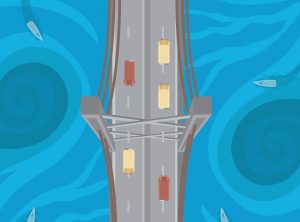 David Lewis’s (I’m coming to accept this new convention with s-ending possessives!) solution to Putnam’s semantic indeterminacy is that we have a network of concepts that interrelate in a manner that is consistent under probing. As we read, we know from cognitive psychology, texts that bridge unfamiliar concepts from paragraph to paragraph help us to settle those ideas into the network, sometimes tentatively, and sometimes needing some kind of theoretical reorganization as we learn more. Then there are some concepts that have special referential magnetism and are piers for the bridges.
David Lewis’s (I’m coming to accept this new convention with s-ending possessives!) solution to Putnam’s semantic indeterminacy is that we have a network of concepts that interrelate in a manner that is consistent under probing. As we read, we know from cognitive psychology, texts that bridge unfamiliar concepts from paragraph to paragraph help us to settle those ideas into the network, sometimes tentatively, and sometimes needing some kind of theoretical reorganization as we learn more. Then there are some concepts that have special referential magnetism and are piers for the bridges.
You can see these same kinds of bridging semantics being applied in the quest to solve some our most difficult and unresolved scientific conundrums. Quantum physics has presented strangeness from its very beginning and the various interpretations of that strangeness and efforts to reconcile the strange with our everyday logic remains incomplete. So it is not surprising that efforts to unravel the strange in quantum physics often appeal to Einstein’s descriptive approach to deciphering the strange problems of electromagnetic wave propagation that ultimately led to Special and then General Relativity.
Two recent approaches that borrow from the Einstein model are Carlo Rovelli’s Relational Quantum Mechanics and David Albert’s How to Teach Quantum Mechanics. Both are quite explicit in drawing comparisons to the relativity approach; Einstein, in merging space and time, and in realizing inertial and gravitational frames of reference were indistinguishable, introduced an explanation that defied our expectations of ordinary, Newtonian physical interactions. Time was no longer a fixed universal but became locked to observers and their relative motion, and to space itself.
Yet the two quantum approaches are decidedly different, as well. For Rovelli, there is no observer-independent state to quantum affairs. The notion that the natural world proceeds according to a causal clockwork logic disappears and is replaced with an underlying quantum network of possible states that is relative to the observer, just like time is relative in relativistic physics. Don’t over interpret “observer” to mean a cognitive agent. An observer is any measuring or impacted, coupled system.
But let me emphasize this: the mistake quantum interpreters have made is that they assumed there is a state to nature out there. Rovelli says no, there’s not. Naturalism is not what we once believed it to be, though he also does not couple it to mind like some idealists. He is very clear about this latter point.
The Rovelli model borders on quantum computing ideas in some ways. The minimal number of yes/no questions that the observer device can ask the quantum system it is observing bears a strong resemblance to current models for quantum algorithmic complexity. This is not surprising, of course, since Rovelli’s model is an information theoretic approach to the difficulties present in understanding quantum interactions.
David Albert’s approach is radically different than this. For Albert, the metaphor applied is similar to the dimensional merging of space and time in relativity, except that there is one extra dimension that underlies quantum reality. What we ordinarily experience is a shadow of that extra dimensional reality projected into our ordinary world. He introduces a series of thought experiments that show how two particles in two dimensions can appear to be one particle in a single dimension.
It feels like Flatland all over again.
But the metaphor has to cover the same territory as Rovelli, so the measurement problem (essentially that the way a quantum system is measured changes the system’s state) is dealt with using this shadow or projection approach. Both realities exist as real projections of the physical properties in the real +1 dimension world, but our interaction with them is just to observe one of the shadows of those projections. There is no wave function collapse, Everett’s multiple worlds is true enough but just embedded in this extra-dimensional place, and any hidden variables are effectively part of the topology of that underlying quantum reality.
There is an interesting note in Albert’s paper where he points out that quantum theory and the tests of it can exist without having his or any conceptual model that reduces our anxiety about the strangeness of quantum reality. Hence his titling the paper as concerning “teaching” the theory and bridging over the difficulties to some ideas that the student can find comforting. But I think it’s more than that. In increasing our understanding of a theory, we may find ways to explore the hitherto untested frontiers of the predictions, and thus to expand the theory in unexpected new ways.
It forms a bridge to the future.